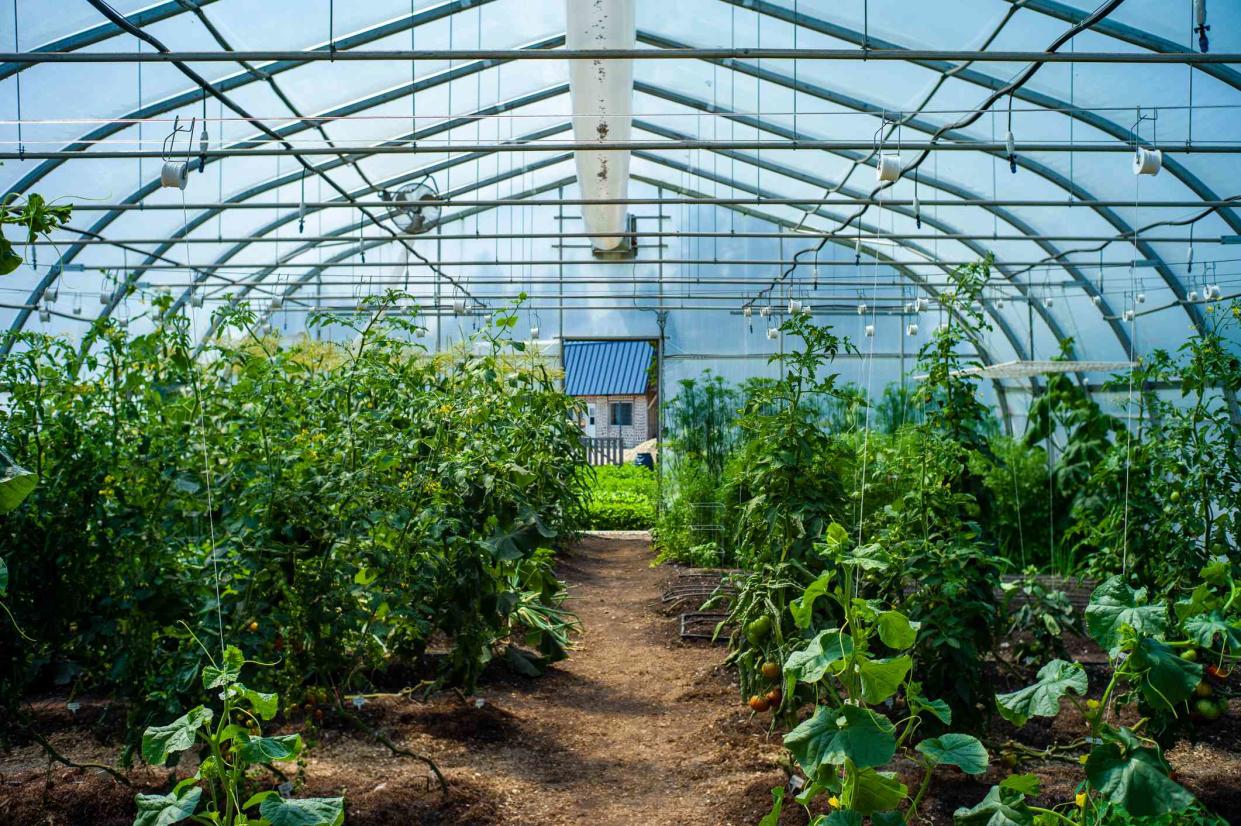All About Hothouse Tomatoes

Alexandre Morin-Laprise / Getty Images
Most home gardeners consider tomatoes a summer crop, but these days they're available year-round largely due to hothouses. Growing fruits and vegetables off-season in a heated greenhouse is a standard practice among commercial growers with varying degrees of success. Hothouse tomatoes, despite dozens of trials and tests, continue to fall short of garden-grown flavor and texture.
Some progress has been made and experts continue efforts for improvement. Small fruits like cherry tomatoes and early determinate plum varieties more closely match summer-grown tomatoes in flavor and texture. Early salad slicers are sold off-season as "vine-ripened" or "on the vine." Even heirloom types, known for their consistent superior flavor, are on the grow list for the hothouse environment. Still, for most varieties, it seems nature has a secret ingredient yet to be discovered.
Learn the basics of hothouse tomatoes, how they're grown, and how they differ from garden tomatoes below.
A hothouse is an artificially-heated greenhouse used to grow perennial plants that can't survive harsh weather.
What Are Hothouse Tomatoes?
Hothouse tomatoes are cultivated, ripened, and harvested in a temperature-controlled, indoor environment during the off-season when weather conditions don't allow planting outdoors. The term "hothouse" refers only to where plants are grown; it is not one specific variety of tomato. Any variety of tomato can be a hothouse tomato. Although they're grown under controlled conditions, fruits are a natural result of cultivation and are not genetically modified. They're simply grown under cover.
Hothouses are how we get tomatoes year-round. Small tomatoes like cherry and grape, plum varieties. and salad types (often called vine-ripened or "on the vine"), and large beefsteak types are all available in winter thanks to hothouses.
While flavor and texture fall somewhat short of seasonal, garden-grown tomatoes, hothouse tomatoes are superior in both texture and taste to tomatoes that were stored for winter use. Those tomatoes are hybrids developed for improved storage quality and long-distance shipping, and they tend to be less appealing in taste and texture.
How Are Hothouse Tomatoes Grown?
A hothouse is greenhouse modified with features to more closely replicate outdoor growing conditions for tomatoes. Seeds are usually started in flats, then transplanted directly into planting beds once seedlings develop an adequate root system and several sets of leaves.
Hydroponic systems are also used for growing hothouse tomatoes. These water-based systems require a substantial capital investment, good management skills, and advanced horticultural know-how.
Hothouse production is heavily controlled with regulated heat, hygiene, watering, and an intense fertilizing schedule. Indeterminate plants are usually pruned to one or two vines with overhead trellising to allow for lengthy growth. Fruits grow upward on the vines. Lower leaves are removed, and tomatoes are harvested as they ripen.
Tomatoes are self-fertile but benefit from pollination by wind and insects. Since hothouses don't allow for wind, growers use large fans. Another common method is to import bumble bees for "buzz pollination." These large native bees fly among the flowers, vibrating their wings which causes pollen transfer between male and female flower parts. Bees are provided shelter and food to keep them working comfortably inside the heated greenhouse.
Garden Tomatoes vs. Hothouse Tomatoes
Compared to garden tomatoes, hothouse tomatoes are more likely to be smaller, blemish-free, and perfectly ripe. The biggest differences between the two result from the conditions under which they're grown.
Tomatoes grown outside in the garden are exposed to the natural elements of rain, insects, and neighboring plants. Even the soil, which you might think of as being unchanging, fluctuates as plants take up minerals, which are then replenished by organisms and microorganisms.
Hothouse tomatoes are grown in a controlled environment without unpredictable fluctuations. A lot of attention is paid to hygiene to eliminate many of the fungal and bacterial diseases that affect tomatoes. As a result, hothouse tomatoes are blemish-free and perfectly ripe. Conversely, specific insect infestations, such as whitefly, and diseases, such as damping off, are more prevalent in the indoor growing environment.
Studies suggest greenhouse building materials may block or dilute ultraviolet rays from the sun, leading to smaller fruit size, lack of flavor, tougher skins, and harder fruits. While some growers harvest rainwater for watering their plants, municipal water sources contain additives that may alter the flavor and texture of greenhouse grown crops.
Frequently Asked Questions
Why do hothouse tomatoes taste different?
Some studies suggest hothouse tomatoes taste different because the materials of a greenhouse could block or reduce UV rays. Hothouse tomatoes and seasonal, garden-grown tomatoes are exposed to very different growing conditions. Efforts to improve flavor in hothouse tomatoes is ongoing.
What are the advantages of growing hothouse tomatoes?
The controlled environment of a hothouse cuts down on many fungal and insect problems which results in perfectly ripe, blemish-free tomatoes. Tomatoes can be grown year round and aren't dependent on the seasons.
How do you grow hothouse tomatoes?
To grow hothouse tomatoes, you need a heated greenhouse, growing medium, and trellising. You need a set schedule for seeding, transplanting, fertilizing, and watering. Fans, hand pollination, or bumble bees would be needed to produce fruit.

